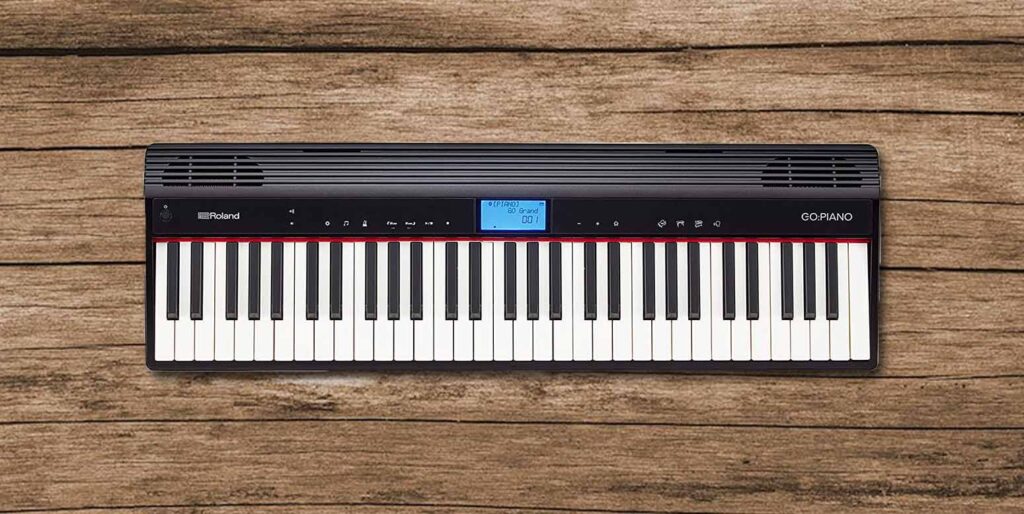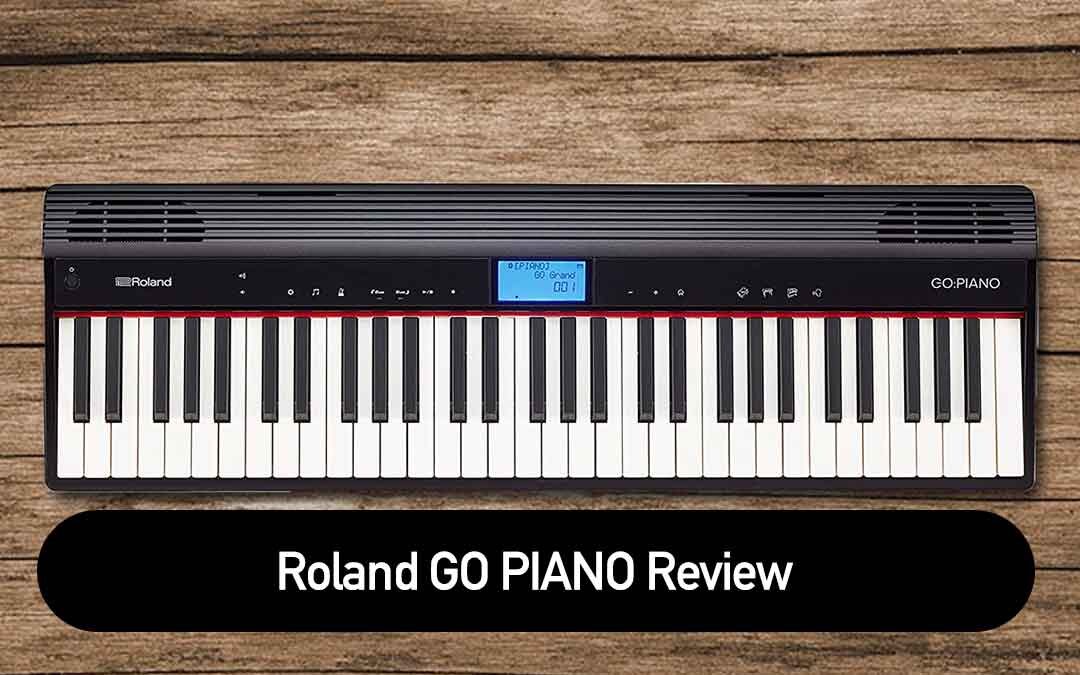Are you a beginner pianist looking for a portable piano from Roland that's easy to use and packed with features? If so, you're probably wondering if the Roland Go Piano is the right choice.
Roland is a well-known brand in the piano industry, known for high-quality digital pianos. It has been one of the leading players in this market for decades and continues to be an innovative brand.
The Roland Go Piano is one of Roland's best portable digital piano keyboards for beginners and musicians on the go.
In this article, I will thoroughly review Roland GO:PIANO 61 so you can decide if it's right for you. In this review, I will take a close look at the following factors:
- Design
- Keyboard & playability
- Sound quality
- Features
- Connectivity
- Accessories
- Price
By the end of this post, you'll better understand whether the Roland GO:PIANO is the right choice for your needs.
So, without further ado, let's get started!
Roland GO:PIANO: A Detailed Review
Quick Overview

The Roland GO:PIANO 61-key Digital Piano is a compact instrument that offers superior piano performance at a reasonable price. Its 61-note keyboard and standard full-size keys provide an authentic touch response for an immersive playing experience.
The Roland GO PIANO has Bluetooth audio/MIDI support, which lets you connect your smartphones or tablets for even more versatility.
It also features high-quality Bluetooth speakers for wireless smartphone connection, making it easy to play and share your music with others.
Since this digital piano has a compact and lightweight design, you can easily store and transport it. Therefore, it is ideal for musicians on the go.
And with the fully wireless operation, including battery power and Bluetooth connectivity, you can play your piano anywhere without needing cords or cables.
Additionally, this digital piano includes Roland's acclaimed piano sounds with 128-voice polyphony and electric pianos, organs, and other sounds.
It also includes three months of free piano lessons with Pianote, the ultimate online piano lesson service. If you own a Roland keyboard piano, you'll get unlimited access to everything inside Pianote, including step-by-step tutorials, live lessons, and teacher support.
You can learn to play your Roland piano from the comfort of your home, anytime you like, and access your lessons from any internet-ready computer, tablet, or phone.
Overall, the Roland GO:PIANO 61-key Digital Piano is an excellent choice for both beginner and experienced piano players looking for a compact and versatile instrument. You can turn your piano goals into a reality with its premium piano performance, Bluetooth connectivity, and free piano lessons.
Note: I'm reviewing the Roland GO:Piano 61 portable keyboard in this blog post. This Roland piano is also available in an 88-key version, though they have quite a few differences. So please keep in mind that this review is only about the 61-key version.
Key Specifications
Let's first look at the main specifications of the Roland GO:PIANO 61-key digital piano.
- Dimensions: 34.5 x 10.7 x 3.2 inches
- No. of Keys: 61 (Ivory Feel and Box-shape Keys with velocity)
- Touch Sensitivity: 3 types, fixed touch
- Voices: 40
- Polyphony (Max.): 128
- Demo Songs: N/A
- Display: Custom LCD (with Backlit)
- Speakers: 2.5 W x 2
- Effects: Chorus, Reverb
- Metronome: Yes
- Pedal: N/A
- Recorder: Yes
- Split Mode: N/A
- Connectivity: Phones/Output jack (1/8″), USB Micro-B type (MIDI), DC In jack, a 1/4″ sustain pedal input jack, and a 1/8″ Aux In jack
- Battery Life: 4-6 hours
- Power Supply: AC adaptor or Alkaline battery
- Color: Black
- Weight: 8.6 lbs (3.9 kg)
Now that we have a brief knowledge of the Roland Go:Piano 61-key, it's time to dig deeper into it!
Design
The Roland GO:PIANO 61-key Digital Piano has a compact and lightweight design, making it an ideal choice for players on the go. The device weighs only 3.9 kg and measures 34.5 x 10.7 x 3.2 inches.
Its simple yet effective design would look great in any apartment or home. The piano's white and black color scheme is eye-catching and gives it a clean, elegant look.
However, the build quality may not meet everyone's expectations, as the body construction feels cheap. The keyboard is made from glossy/satin plastic, and its lightweight design leaves a bad first impression.
Although some people like the look, your mileage may vary.
Thankfully, the front panel control area has a matte finish, which helps reduce fingerprints and enhances its overall appearance.
This digital piano also has a red felt cloth behind the keys that adds a premium feel, even though it doesn't serve much of a purpose.
The underside of the keyboard does not seem to be sturdy.
Unlike most keyboards, the GO:PIANO shows how little plastic is used at its bottom. The lightweight construction of the piano gives an apprehension about its sturdiness.
But the piano didn't bend during play, even with forceful playing fortissimo.
User Interface
The user interface of the Roland GO:PIANO is easy to use. It uses smooth touch buttons and has a basic menu screen. Once you get the hang of it, the interface is pretty simple.
Although some players don't like smooth buttons, they prefer a more tactile interface. However, when you make selections, you get audible beeps (if you want), so you get confirmation that you've pressed the button. You'll become accustomed to them pretty quickly.
On the left, there is volume control, then a button to access the settings menu, built-in songs, as well as recording and playback of your own play. The octave shift up and down buttons are a standout feature, making it easy to adjust the octave without navigating through menus.
The right side of the menu has +/- keys for menu navigation, a "home" button to return to the main menu, and voice category navigation buttons.
Overall, the user interface is simple once you get used to it, and the audible beeps provide feedback when making selections.
Keyboard
This Roland Go Piano features a 61-note keyboard with standard full-sized keys designed to offer a realistic playing experience.
Since the piano keys have full-size, they feel very similar to a traditional piano. This is a plus for beginners as they can transfer their playing habits from the Go Piano to other pianos.
Also, the keys have a matte finish which helps reduce slipping during play.
Like real piano keys, the keys are box-shaped. These box-shaped keys respond beautifully to your touch, making playing effortless and enjoyable.
While there are no weighted keys, they are touch-sensitive. The keyboard offers three types of sensitivity levels, allowing you to choose the most appropriate settings for your playing style.
Overall, the keys feel nice and easy to play on the Roland Go:Piano 61, offering a great playing experience for beginners and intermediate piano players.
Sound
The sound quality of the Roland GO:PIANO is excellent. The piano samples are clear, rich, and full of depth.
With its clean and clear sound, the Roland Go Piano has a similar sound to an acoustic or grand piano, which is better than most portable keyboards at the same price point.
The sounds on this digital piano are derived from Roland's acclaimed premium pianos.
Voices
The original 61-key GO:PIANO features 40 voices. Here is a list of the included sounds:
- 10 Acoustic piano sounds
- 7 electric piano sounds
- 7 organ sounds
- 16 "other" sounds (a drum kit, a sound effects set, and others)
The sounds are generally good, and some are admittedly hilarious inclusions, such as the Jazz Scats.
Sadly, you cannot layer or split the voices; the keyboard still offers a decent piano and strings voice and an awe-inspiring piano and pad voice found in the piano section.
Effects
This Roland model also offers some piano sound effects, so you can customize the sound of your music to suit your taste. It includes chorus and reverb sound effects.
Certain Roland GO:Piano 61 voices have a chorus effect, but you cannot modify it. In addition, some piano voices feature damper resonance (which you cannot control).
This piano also features a reverb effect with adjustable levels. There are ten levels from 0-10. You can tweak the intensity between 0-10. The algorithm emulates a hall reverb to help give the sound a sense of space. Some sounds come with reverb by default.
Polyphony
The Roland digital piano has 128-note polyphony, allowing you to play complex compositions easily.
Polyphony is the number of notes you can play simultaneously without cutting off samples. The 128-note polyphony means you're likely to have enough notes while performing.
Speaker System
The Roland Go Piano 61 also features 12cm x 2 + 6cm x 2 built-in speakers, offering a high-quality sound. Each speaker produces 2.5W. This results in a total output power of 6W.
Although they are not the most powerful speakers, they are good enough for home practice. The sound quality is slightly better than average for a piano keyboard like this.
Features
The Roland GO:PIANO is packed with features that make it an excellent choice for both beginners and professional pianists. Some of its best features include:
Roland Piano Partner 2
One of the impressive features of the Roland GO:Piano 61 is its compatibility with Roland's free app Piano Partner 2. It is a free piano app designed to help you learn piano and develop your music skills.
This app provides interactive features for Roland digital pianos, including sheet music displays, lessons, and piano accompaniments.
Roland knows that accompaniment features are a necessity for many beginners. So they've included this functionality through the Piano Partner 2 app, which also serves as a recording and educational tool.
With the app, you get the standard accompaniment options, and it tracks your chords with Bluetooth, playing off the corresponding backing.
Please Note: In keyboard courses, the accompaniment features of the app are not a replacement for arrangement keyboards.
With Piano Partner 2, you can quickly expand your musical capabilities and enjoy the full potential of the Roland piano.
Metronome
The Roland digital piano also features a built-in metronome. It helps you keep a consistent tempo, so you don't inadvertently speed up or slow down.
You can use a metronome to practice playing at different tempos and to improve timing and rhythm. The piano keyboard lets you set variable time signatures and a tempo from 5-300.
With this feature, you can stay on time and play in sync with other musicians.
Transposer
The Roland Go Piano digital piano also features a transposer function. Piano players can use this feature to change the key of the notes according to their preferences. You can move up or down within a 12-semitone range if unfamiliar with the key signature.
Single Song Recorder
The Roland GO: Piano 61 features a built-in MIDI song recorder (single-track song recorder) that is relatively easy to access and can store more than one song.
You can't overdub or edit in any way, so it's just a handy way to get an idea for that new hit song you're writing.
To record a song, you will need to use a device with recording software like GarageBand on an iPad, either by using the micro-USB port to send MIDI data or the headphone port with a splitter cable to transmit audio data to your recording device.
Connectivity
When it comes to connectivity, the Roland GO: PIANO will not let you down. It offers a range of connectivity options that make it easy to connect with other devices, such as your computer or mobile device.
You can connect it to a computer or mobile device via USB or Bluetooth, so you can use your favorite music software.
It also includes a 1/4" headphone jack for practicing quietly without using speakers. If you want to use external speakers, you'll need to use this jack, but keep in mind that you'll need to work with converters.
Additionally, this piano keyboard features the 1/8" Auxiliary In jack that allows you to connect your smartphone or media player to use the built-in speakers. It is the best option if you don't like using Bluetooth due to reliability issues.
Lastly, the 1/4″ Pedal jack lets you connect a sustain pedal. On the 61-key version, the front panel has a light that indicates when a pedal is connected.
You can easily use this digital keyboard piano with its range of connectivity options. These connectivity options make the Roland GO: PIANO a versatile, user-friendly choice for musicians.
Accessories
The Roland piano offers a few accessories to make it easy to set up and start playing right away. The accessories include:
- Music stand
- AC adaptor
- Owner's manual
- Leaflet "USING THE UNIT SAFELY"
I like these keyboard accessories because they are all good quality and make the keyboard much easier to use.
Additionally, you can purchase some other accessories separately. For example, you should purchase a separate damper pedal (sustain pedal) if you are serious about learning how to play piano.
Price
Price is one of the most crucial factors when choosing a digital piano. You want to get the best value for your money, especially if you're on a limited budget.
The Roland Go:Piano 61- key retails for around $314.99 on Amazon. The price is a little higher than some other options.
If you're on a tight budget, you might consider the Yamaha NP-32. Although the Roland Go:Piano has better sounds, the Yamaha NP-32 is still one of the best keyboard pianos for beginners who don't need arrangement features.
It falls in the $300 price range, which makes it a more affordable option than the Roland Go Piano.
However, if you're looking for a digital keyboard that can go with you on road trips, the GO:PIANO is an option worth considering. You can use it to practice anytime, anywhere, and even jot down ideas when inspiration strikes.
Pros and Cons of the Roland Go Piano
We've reviewed all the features of the Roland Go:Piano (61-key) in detail. Now let's summarize its pros and cons!
Pros
- Simple yet effective design.
- The device is very light and portable, so you can take it wherever you go.
- It has full-sized touch-sensitive keys that respond well to the user's touch.
- Easy-to-use controls.
- Offers a wide range of good quality and impressive sounds.
- Compatible with Bluetooth MIDI technology.
- It can connect to various devices to enhance your playing and recording experience.
- Ideal for both beginners and younger players.
Cons
- The price is a bit high.
- The build quality isn't great.
- The keyboard has non weighted keys.
- It lacks split and layer modes.
Who should buy Roland Go:Piano (61-key)?
In my opinion, the Roland Go:Piano is an excellent choice for traveling musicians and beginners. It is suitable for younger players who want to develop music-making, songwriting, and production skills.
The only downside is its price and abundance of features, which might not be ideal for all younger users.
Overall, this keyboard piano is the best option for young aspiring piano players and traveling musicians.
Conclusion
After thoroughly reviewing the Roland Go Piano, it's clear that this is one of the best portable keyboards for traveling pianists.
With its excellent sound quality and connectivity, the Go Piano is perfect for novice and expert pianists looking for portability.
While it has only 61 keys without counterweight, it has good key response thanks to its pressure sensitivity and keyboard speed system.
Remember that the Go Piano is only ideal for people who want to travel and learn to play the piano, but if you want a keyboard for music production or more functions, you should look at something else.
Now I'd like to hear from you!
Have you ever used this Roland Go Piano before? What is your opinion on this model? Please share your experience or thoughts in the comments.
Related Topics
- How To Ship A Keyboard Piano?
- Simply Piano vs Yousician: Which One is Better?
- About Electronic Keyboard Brands On The Market
Harlan Kilstein began playing piano during covid with no piano background at all. He taught himself how to play learning what to do and what not to do.
Today he's an advanced intermediate player and can help you grow in your skills because he learned all this on his own.








